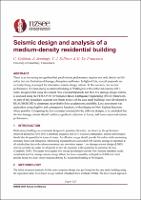| dc.contributor.author | Gribbon, Cameron | |
| dc.contributor.author | Jennings, Zayne | |
| dc.contributor.author | De Francesco, Giovanni | |
| dc.contributor.author | Sullivan, Timothy | |
| dc.date.accessioned | 2021-06-22T04:01:58Z | |
| dc.date.available | 2021-06-22T04:01:58Z | |
| dc.date.issued | 2021-04-14 | |
| dc.identifier.uri | https://repo.nzsee.org.nz/xmlui/handle/nzsee/2390 | |
| dc.description.abstract | There is an increasing recognition that good seismic performance requires not only checks on life-safety but also limitation of damage, disruption and losses. In light of this, several proposals are currently being developed for alternative seismic design criteria. In this research, the seismic performance of a four-storey residential building in Wellington with reinforced concrete (RC) walls, designed first using the current New Zealand Standards and then low damage design criteria, is assessed using the FEMA P-58 Performance-Based Earthquake Engineering (PBEE) framework. As part of this procedure, accurate non-linear models of the case study buildings were developed in RUAUMOKO3D to determine the probable floor accelerations and drifts. Loss assessment was undertaken using fragility and consequence functions, with reference to New Zealand functions where possible. Comparing the loss estimates obtained for the different designs, it is concluded that the low damage criteria should lead to a significant reduction in losses, and hence improved seismic performance. | |
| dc.language.iso | en | |
| dc.publisher | New Zealand Society for Earthquake Engineering | |
| dc.relation.ispartofseries | 2021;0128 | |
| dc.subject | Communicating seismic risk and mitigation strategies | |
| dc.subject | Resilience beyond life-safety and amenity | |
| dc.subject | Advancements in structural and geotechnical design and assessment | |
| dc.title | Seismic Design and Analysis of a Medium Density Residential Building | |
| dc.type | Article | |

